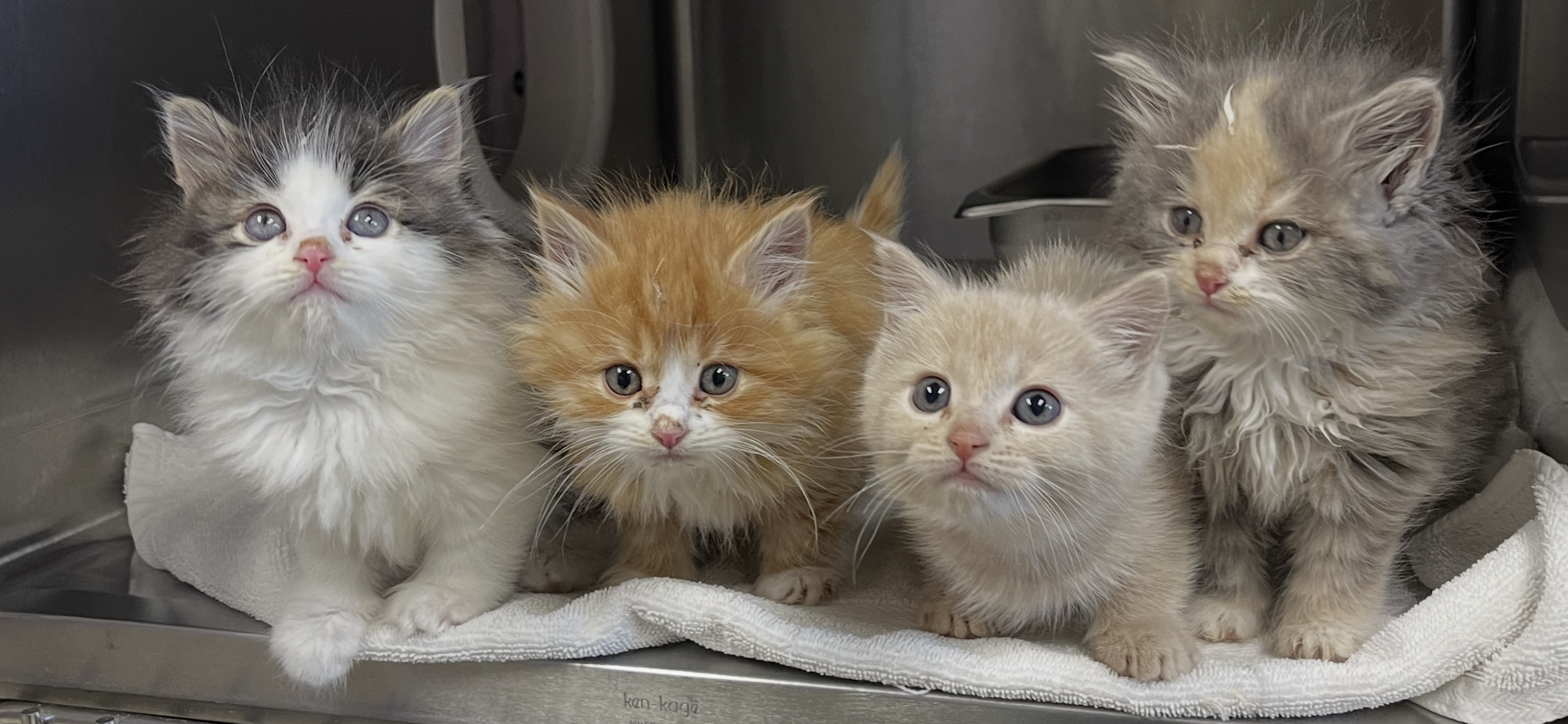
TNR
(TRAP, NEUTER, RELEASE)
Neighborhood Cat Program
Helping outdoor cats—and the people who care about them
Many cats in our community live outdoors. Some are owned cats that roam; others are unowned “community cats.” Our goal is to keep healthy cats safe and reserve shelter space for animals in true crisis. That’s why we focus on Trap–Neuter–Return (TNR) and Return to Home (RTH)—nationally recognized approaches that reduce litters and nuisance behaviors while improving welfare.
What we do
TNR appointments for community cats: Subsidized spay/neuter, core vaccinations, ear-tip, recovery, and return to their outdoor home.
Return to Home (RTH): Healthy, unidentified cats brought to the shelter are scanned, assessed, sterilized when appropriate, and returned to the exact location where they were found.
Why these methods? RTH/TNR programs maximize cat welfare, reduce nuisance concerns, and minimize reproduction—outcomes backed by national guidance and research.
What we can’t do (and why)
We’re often asked to take in every outdoor cat, provide full medical care, and rehome them. That’s not realistic for any shelter—and it isn’t best for most outdoor cats.
Finite capacity & funding: Space and dollars must go first to sick, injured, orphaned, or at-risk animals.
Healthy outdoor cats are typically doing fine: Body condition and behavior show they’re finding food/shelter; removing them doesn’t fix the root issue.
The “vacuum effect”: Remove cats and new, unaltered cats fill the space. Sterilized cats returning home help stabilize the area.
Shelter stays can harm healthy cats: Crowding raises stress and disease risk; RTH/TNR avoids that and saves resources for animals who truly need kennels.
SCHEDULE a TNR APPOINTMENT:
Email: tnr@wenatcheehumane.org or call our Community Programs Coordinator at 509-423-9376 (Tuesday -Saturday)
Cost: $49
Includes: medical exam, spay/neuter, core vaccination, ear-tip, and return instructions.
Who qualifies? Unowned, free-roaming cats supported by a caregiver or stable in their outdoor territory. (We’ll help you determine eligibility.)
What to expect (step-by-step):
Request an appointment → 2) Humane trapping guidance and supplies list → 3) Surgery & recovery → 4) Return to the same location → 5) Neighborhood follow-up (deterrent tips, monitoring).
Transparency moment
WVHS operates within a fixed budget and limited space. Prioritizing medical cases, cruelty/neglect, dangerous situations, and underage kittens is how we save the most lives. RTH/TNR lets us do that responsibly and aligns with national recommendations. Our vision, like you, is that all animals have a home, & we hope with the support of our community that vision will one day be realized.
Neighborhood benefits
Fewer kittens (sterilized cats can’t reproduce)
Less nuisance (neutering reduces spraying, fighting, and yowling)
Community health (vaccination at surgery helps protect the colony)
Shelter impact (space/time go to animals in crisis
What you can do right now
Caregiver guide: We’ll help you with feeding stations, winter shelters, and monitoring.
Lost or found cat? Try a paper collar with your number, knock on doors, and post locally before bringing a healthy cat to the shelter.
Found kittens? Unless they’re in danger, wait and watch for mom; she’s usually nearby.
Need deterrents? We can share humane tactics to keep cats off porches, gardens, and vehicles. Email tnr@wenatcheehumane.org for support.
FAQ
-
‘Community cat” is a term that describes any unowned cat that is outdoor and free-roaming. These cats may be routinely fed by one or more community members or they are surviving on their own, and may be social or unsocialized.
-
As of 2018, WVHS no longer participates in the “catch and remove” method of controlling cat colony populations. TNR is a method of humanely trapping community cats, having them brought to the shelter to be spayed or neutered, vaccinated, ear-tipped, and returned to their outdoor homes.
A community cat is an unowned, free-roaming cat that lives outdoors. To effectively manage the behaviors of free-roaming cats in our community, such as breeding, spraying, and fighting,
Wenatchee Valley Humane Society takes a two-pronged approach:
1. Trap, Neuter, and Return (TNR) is a comprehensive effort within specific communities to humanely trap, sterilize, vaccinate, and return these free-roaming cats to the community, significantly reducing the number of kittens born in these areas.
2. The Return to Home (RTH) program is for free-roaming cats brought to the Wenatchee Valley Humane Society. If they are determined to qualify for a return to their outdoor homes, the cats are then sterilized and returned to the neighborhood in which they were found.
To identify community cats that have been part of these processes so that they are not readmitted, the Wenatchee Valley Humane Society uses the industry-standard practice of ear-tipping.
With effective community cat programs, cats are returned to their original outdoor homes after they’ve been spayed or neutered and vaccinated. This prevents new cats from moving into the area. Altered cats will not continue the cycle because they cannot have kittens resulting in a reduction in population size over time. This is the only humane and effective way to manage populations of community cats.
-
Return-to-Home (RTH) is the same as TNR, but it has one small difference. The TNR program relies on members of the public to trap community cats and bring them to the clinic. The RTH program has been implemented for community cats brought to the shelter and the WVHS team releases the cats after TNR. When cats are brought in, our team of animal welfare professionals will examine the cat and determine if they are a candidate for release back to their community home.
-
Community cats populate an area when there’s food and shelter to support them. If the cats are removed, other cats will find the vacant space and move in for the same reason as the original cats- there’s food and shelter. This is called the vacuum affect. The new cats will have more kittens, and repeat the cycle. With TNR/RTH, the original cats are returned to the territory after they’ve been spay/neutered, so that new cats will not move into that area. These cats, who’ve received spay/neuter, will not continue the process because they cannot have kittens.
-
We focus on Trap–Neuter–Return (TNR) and Return to Home (RTH) for healthy outdoor cats. These approaches reduce litters and nuisance behaviors and keep shelter space available for animals in crisis.
Why not bring every outdoor cat to the shelter?
Shelter kennels are best used for sick/injured animals, unsafe situations, and young kittens. Healthy outdoor cats typically have what they need where they live; sterilizing and returning them prevents more kittens and cuts behaviors like yowling and spraying.Do cats really do okay outdoors?
Many community cats are in good body condition and supported by neighbors (food/shelter). After TNR, they’re fixed, vaccinated, and ear-tipped, which stabilizes the local population and improves welfare.Is RTH/TNR a “do nothing” approach?
No—it's targeted care. We assess, scan, sterilize when appropriate, vaccinate, and return cats to the exact found location. That’s how we reduce intake pressure and focus resources on animals that truly need treatment or placement.When should I bring a cat to the shelter?
Sick, injured, or unsafe location
Kittens too young to fend for themselves
Clear signs of ownership and can’t remain where found
Not sure? Call us—we’ll help decide the best path.
-
Ear-tipping is a way of signaling that a community cat has been spayed or neutered. This procedure is done by a licensed veterinarian during the spay/neuter process, and it involves removing a small portion of the cat’s ear. It is a humane and safe procedure that prevents unnecessary trapping of a cat who has already been spayed/neutered.
-
If a cat keeps visiting, it’s because there’s a resource nearby—usually food, water, or shelter. Remove the draw, and most cats move on.
Remove the food draw
Pick up pet food and scraps; secure compost and trash with tight-lidded bins.
Clean up fallen fruit and excess bird seed; scrape BBQ grates.
Limit water access
Fence off ponds/pools if possible; fix drips and standing water.
Block shelter spots
Close off spaces under decks, sheds, and porches with ¼–⅓" galvanized hardware cloth.
Bury the bottom ~6" and flare outward 12" in an L-shape to deter digging.
Trim tree branches 5' away from roofs; thin shrubs to create ~18" of open space at ground level.
Make areas less comfy
Under mulch, lay chicken wire or plastic carpet runner (spikes up) so digging isn’t pleasant (humane, doesn’t harm).
Use citrus peels/coffee grounds or a citrus garden spray as a mild scent deterrent.
Use motion-activated sprinklers
A motion sprinkler gives a quick burst of water when a cat enters—effective and safe for wildlife (also works on raccoons, opossums, etc.).
-
